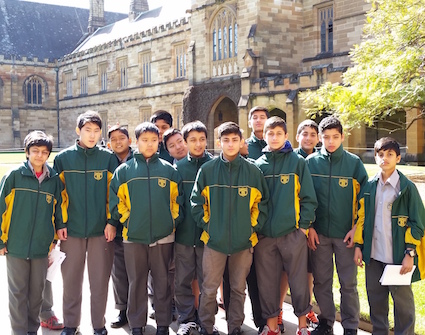
Year 7 Granville students at the University
Over the past four years, several groups of students from Granville Boys High School have visited the University of Sydney as part of the Social Inclusion program – usually Year 11 students completing individual research projects. On the 12th and 17th of August, the university hosted four classes of Year 7s in a pilot for a Project Based Learning program.
For this new project, Granville students will be investigating ancient artefacts and human remains, particularly looking at how remnants of the past are used to bring history to life in the present-day. Their case studies will include Ancient Egyptian mummies, Otzi the Iceman, and closer to home, Mungo Lady and Mungo Man. The students visited the Nicholson and Macleay museums to get a closer look and a better understanding of the importance of artefacts and remains, as well as the processes of preservation, storage, and presentation.
At the Nicholson Museum, the students handled artefacts such as canopic jars, ceramic sherds, mummy wrappings, grave-robber lamps, and Sumerian tablets. While handling these collections, they applied a series of questions to determine each object’s material, date, and place of origin. In the end it was the two swords – one Cypriot, the other Mycenaean – that drew the most attention from the students.
The staff at the Nicholson Museum were terrific guides and hosts for the boys. Craig Barker also took a group for an impromptu chat about the mummies, but quickly found out that at least one of the boys had been doing a little work on his own, and could describe the process of mummification down to the finest detail. His friends, along with us, were amazed.

Dr Craig Barker with students in the Nicholson Museum
After learning about the material cultures of ancient civilisations at the Nicholson, the students explored Macleay Museum’s natural history collection. Upon their arrival, Jude Philp, Senior Curator at Macleay, tasked the students with locating the oldest and weirdest objects on display. Several of the students were also determined to find fake objects – but turns out the entire collection is real! Even at the end of what was quite a long day, the students were bursting with questions about the scientific instruments and animal life on display, how they were collected, and what it is like working in a museum.
We are looking forward to seeing their projects at school. And judging by their enthusiasm for learning about the history of the University and how we study history at the University and Museums, we are also looking forward to having them as students in a few years’ time.
